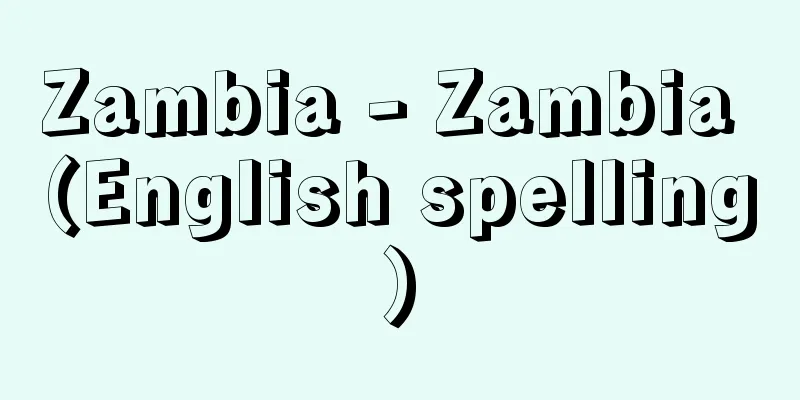Zambia - Zambia (English spelling)

|
A landlocked republic in southern Africa. Its official name is the Republic of Zambia, and it was called Northern Rhodesia before independence. It borders Tanzania and the Democratic Republic of the Congo to the north, Malawi and Mozambique to the east, Angola to the west, and Namibia, Botswana, and Zimbabwe to the south. It has an area of 752,614 square kilometers and a population of 10.72 million (estimated as of 2000). Its capital is Lusaka. [Akifumi Hayashi] NatureThe whole country is highland, 900-1500 meters above sea level, and the Zambezi River runs along the southern border with Zimbabwe. There are lakes such as Lake Mweru and Lake Bangweulu in the north, and the artificial lakes Kafue and Kariba in the south, as well as the Rukanga Swamp in the center, but most of the country is highland savanna. On the Zambezi River near the southern town of Livingstone (now Maramba), there is the Victoria Falls, the largest waterfall in Africa, discovered and named by the great explorer Livingstone, from whom the town is named. In addition, near the central border with the Democratic Republic of the Congo, there is a large copper-producing area known as the Copper Belt. In the eastern and southern areas along the railway line, red and reddish-brown loamy layers have been developed by white people into large farms for sale, but the remaining areas are poor and poor, and Africans practice subsistence farming. [Akifumi Hayashi] historyIn 1889, Cecil Rhodes' British South Africa Company attempted to expand north of the Limpopo River, and after acquiring Southern Rhodesia (now Zimbabwe), in 1890 it obtained mineral mining rights from King Lewanika of the Lozi Kingdom on the upper reaches of the Zambezi River. From 1897 to 1899, it took control of the whole of Northern Rhodesia under the pretext of protecting the Bemba people in the north from attacks by the Ngoni people. However, the Company's interest was in Southern Rhodesia's mineral resources and white settler farms, and in Northern Rhodesia it only built a railway to Kabwe in 1909. In the early 1920s, white settlers' resentment against the Company's rule grew, and as a result of a referendum, Company rule ended in 1924 and the country became a British protectorate governed by the Colonial Office. It was from this time that Northern Rhodesia was distinguished from Southern Rhodesia. In the late 1920s, rich copper deposits were discovered on the Copper Belt, which was exploited by the American Lone Selection Company and the South African Anglo American Company. After World War II, the mines produced one-eighth of the world's copper. White settlers in Southern Rhodesia were interested in these copper resources, and also in the black labor force of Nyasaland (now Malawi), and planned to form a federation among the three countries of Southern Rhodesia, Northern Rhodesia, and Nyasaland. In 1953, the Federation of Rhodesia and Nyasaland was established. The Africans in the three countries opposed the federation, which was intended to benefit whites, and in Northern Rhodesia, H. Nkumbula founded the African National Congress (ANC) in 1951, with K. D. Kaunda joining. In 1958, the radical Kaunda left the party and formed a new party, but it was outlawed and he was imprisoned. In 1960, Kaunda became the leader of the United National Independence Party (UNIP) and negotiated with the British government, opposing federation and demanding independence.The Federation of Rhodesia and Nyasaland was dissolved in December 1963, and Northern Rhodesia achieved independence on October 24, 1964, changing its name to the Republic of Zambia. [Akifumi Hayashi] PoliticsAs president, Kaunda advocated African socialism based on humanism and nationalized key industries. He also amended the constitution to outlaw the opposition parties, the Unity Party (UP) and the United Progressive Party (VPP), and established a one-party system under the UNIP in 1973. However, the Zambian economy faced a crisis due to the oil crisis in 1973 and the collapse of the international price of copper in 1975. To overcome this economic crisis, President Kaunda was forced to accept the Structural Adjustment Programme (SAP) of the International Monetary Fund (IMF) and the World Bank. The SAP, which sought to liberalize the economy, dealt a particularly heavy blow to urban residents, and the Movement for Multiparty Democracy (MMD) was formed in July 1990, centered around F. Chiluba of the miners' union, and became a major movement calling for a transition to a multiparty system. In response to this situation, UNIP established a Constitutional Reform Committee in September 1990 and repealed Article 4, which prohibited the formation of political parties other than UNIP. As a result, presidential and national elections were held under a multi-party system in October 1991, with Chiluba winning the presidential election and the MMD winning by a landslide in the national election, resulting in the defeat of the Kaunda government, which had been in power for 27 years since independence. However, after Chiluba's administration came to power, criticism arose within the MMD over the president's lack of leadership and cabinet corruption, leading to the MMD splitting apart. Seeing this, Kaunda, who had retired from politics, announced his candidacy for the 1996 presidential election again. In response, Chiluba amended the constitution to require a presidential candidate to be a second-generation Zambian citizen, making it impossible for Kaunda to run. As a result, Chiluba was re-elected in the November 1996 presidential election, and the MMD also won by a landslide. UNIP boycotted the election, and the international community also criticized Chiluba's constitutional amendment measures. In January 2002, a presidential election was held to mark the expiration of the term of office, and Levi Mwanawasa (1948-2008) of the MMD was elected. The presidential term is five years. [Akifumi Hayashi] Diplomacy and MilitaryAfter independence, Zambia joined the United Nations, the Commonwealth of Nations, and the Organization of African Unity (OAU, now the African Union), and made anti-racism and non-alignment the basis of its diplomacy. It played an active role in the African liberation struggle against the white-ruled countries of Southern Africa in particular. The Lusaka Declaration, which advocated "negotiation over destruction" and was adopted by 14 East and Central African countries in 1969, was later adopted by the OAU and became the basis of the Southern African liberation struggle. It also immediately responded as the "voice of reason" to South Africa's détente policy in 1974, and represented the moderate faction among the Frontline countries (Zambia, Tanzania, Angola, Mozambique, and Botswana) that were formed that same year. Behind its moderate course was always Zambia's economic interests, especially the issue of securing a copper export route that would have to rely on South Africa's railways and ports. During the Zimbabwean struggle, Zambia supported the Zimbabwe African People's Union (ZAPU), and during the Angolan struggle, Zambia supported the moderate National Union for the Total Independence of Angola (UNITA). In 1973, Zambia closed its borders to support the Zimbabwean liberation struggle, but in 1978, due to a domestic economic crisis, it reopened the border, which was a key transportation route for the landlocked country of Zambia, drawing criticism from other frontline countries. Reflecting the situation of the national liberation struggles in southern Africa, defense spending accounted for 30% of the national budget by the end of the 1970s. As of 1995, the country had a military force of 21,600 (20,000 in the army and 1,600 in the air force) and 16 fighter jets. [Akifumi Hayashi] economyZambia is a typical monocultural economy dependent on copper, with copper accounting for 18.5% of gross domestic product (GDP), 50% of national revenue, and 95% of exports (1996). After independence, the Mulungushi Declaration was announced in 1968 based on the Humanistic Socialist policy, which stipulated that the state-run Industrial Development Corporation (INDECO) acquire 51% of the shares of 26 major foreign private companies, and also restricted remittances to the home country. The following year, 1969, the state-run Mining Development Corporation (MINDECO) also acquired 51% of the shares of copper mining, the country's key industry, and the two previous major foreign copper companies, Lone Selection Trust Co., Ltd., was transferred to Lone Consolidated Mining Company (RCM) and Anglo American Co., Ltd., to Nchanga Consolidated Copper Mining Company (NCCM). Furthermore, in 1970, the state-run Financial Development Corporation (FINDECO) acquired a majority stake in place of foreign commercial banks, giving the government control over 95% of financial activities. Although the above measures led to the Zambianization of the economy, the Zambian economy fell into a crisis in the late 1970s due to the copper export route and fluctuations in the international price of copper. When the white forces of neighboring Rhodesia (now Zimbabwe) unilaterally declared independence in November 1965, Zambia cooperated with the UN's economic sanctions against them, which made it difficult to use the Rhodesian Railway, which had previously been used for two-thirds of copper transportation, and the country sought alternative routes. In 1970, China began construction of the 1,600-kilometer Tanzania-Tanzanian Railway, which linked the copper-producing areas with Tanzania, and was completed in 1975. However, in August of the same year, the civil war in neighboring Angola destroyed the Benguela Railway, another pillar of transportation capacity alongside the Rhodesian Railway, and copper transportation was concentrated on the Tanzania-Tanzanian Railway. However, the railway's inefficiency and the port's limited loading capacity put copper exports in a crisis. Meanwhile, reflecting the world economic downturn following the 1973 oil crisis, the international price of copper fell below production costs from 1975 onwards, and the government imposed production restrictions on copper companies. This led to a decline in Zambia's foreign currency and a reduction in imports of necessities, leading to shortages of goods and inflation and increasing public discontent. The government responded to the economic crisis with large loans from the World Bank and the International Monetary Fund (IMF), and in October 1978, despite opposition from frontline countries, it resumed operation of the Rhodesian Railway. Reflecting on this problematic over-reliance on copper, the government is now concentrating on domestic agricultural development, particularly on achieving self-sufficiency in food. There is a large regional disparity between the white farms along the railway line (which produce corn, wheat, sugarcane, and tobacco) that serve the markets, and the other African self-sufficient agricultural areas (which produce corn, rice, groundnuts, and cotton), and the government is working to improve productivity in the latter through assistance with irrigation, seeds, fertilizers, and other items. The Structural Adjustment Programme (SAP), introduced in 1983 at the request of the IMF and the World Bank, was at odds with the socialist approach and increased dissatisfaction among the people (especially urban residents), which manifested itself in urban riots. The Chiluba administration that came to power in 1991 took over the SAP and promoted deregulation, currency liberalisation, and privatisation of public enterprises, but this led to rising inflation and put a strain on people's lives. [Akifumi Hayashi] Society and CultureZambia's population density is low at 14 people per square kilometer, but the population growth rate is high at 3.1% (1990-98). The inhabitants are made up of 73 tribes, the main ones being Tonga (central and southern), Nyanja (eastern), Bemba (northern and copperbelt), Lunda (northwestern), and Lozi (western). The official language is English, but other tribal languages are also used. Traditional religions are practiced in rural areas, but Christians predominate in the cities, numbering about 6 million. Due to the regional disparities mentioned above, there is an extremely high migration of population from rural areas to cities, and the urbanization rate of the population increased from 30% in 1970 to 50% in 1995, resulting in serious economic and social problems such as an increase in unemployment, a housing shortage, and a lack of medical and educational facilities. The rapid Zambianization policy also led to inefficiencies within state-run public companies, so in 1977 the Industrial Development Act was enacted to provide preferential treatment for foreign private capital investment, and the state-run public companies were repeatedly restructured. In April 1982, the two major copper companies were merged into the Zambia Consolidated Mining Company (ZCM). At the time of independence, there were only less than 100 university graduates, but since then, the country has placed emphasis on education, investing 14% of annual government expenditures and 5% of gross domestic product (GDP) in it, resulting in a primary school enrolment rate (for ages 7-13) of 75% and an adult literacy rate of 73% in 1995. Daily English-language newspapers, The Times of Zambia and The Zambia Daily Mail, are published, and radio and television are broadcast by two state-run companies. [Akifumi Hayashi] Relations with JapanThrough the import of copper bullion, Japan has an annual trade surplus, with imports amounting to $221.82 million in 1995 and exports $60.05 million, with exports from Japan mainly consisting of transport machinery, communications equipment and chemical fertilizers. From the first yen loan in 1972 to 1995, government aid totaling 90.024 billion yen was provided to the transport and communications sector. On the occasion of President Kaunda's visit to Japan in September 1980, grant aid of rice worth approximately 200 million yen was provided. Furthermore, technical cooperation is being implemented through the Japan Overseas Cooperation Volunteers, the dispatch of experts and the acceptance of trainees, as well as private investment (in fertilizer, explosives factories, automobiles and banks). [Akifumi Hayashi] "Labor Mobility and Social Change: The Lives of the People in Zambia" by Mitsuo Ogura (1995, Yushindo Kobunsha) [Supplementary Material] |"> Zambia flag ©Shogakukan Illustration/Shogakukan Creative "> Zambia Location Map Source: Shogakukan Encyclopedia Nipponica About Encyclopedia Nipponica Information | Legend |
|
南部アフリカの内陸にある共和国。正称はザンビア共和国Republic of Zambia、独立以前は北ローデシアと称した。北はタンザニア、コンゴ民主共和国、東はマラウイ、モザンビーク、西はアンゴラ、南はナミビア、ボツワナ、ジンバブエと国境を接する。面積75万2614平方キロメートル、人口1072万(2000推計)。首都はルサカ。 [林 晃史] 自然全国土が標高900~1500メートルの高地で、南側ジンバブエとの国境はザンベジ川が流れている。北部のムウェル湖、バングウェウル湖、南部のカフエ人造湖、カリバ人造湖などの湖沼のほか、中部にルカンガ沼沢地があるが、大部分は高地サバンナ帯である。南部の町リビングストン(現マランバ)近くのザンベジ川には、この町名の由来となった大探検家リビングストンが発見し命名したアフリカ大陸最大の瀑布(ばくふ)ビクトリア滝がある。また、中部のコンゴ民主共和国国境付近にはコッパー・ベルトとよばれる大産銅地帯がある。東部と南部の鉄道沿線の赤色、赤褐色ローム層地帯は白人によって市場向け大農場が発達しているが、残りの地域は地味もやせておりアフリカ人が自給自足農業を行っている。 [林 晃史] 歴史1889年セシル・ローズのイギリス南アフリカ会社はリンポポ川北方への進出を企て、南ローデシア(現ジンバブエ)を手に入れたのち、ザンベジ川上流のロジ王国のレワニカ王から90年鉱物採掘権を入手した。さらに97~99年には北方のベンバ人をヌゴニ人の襲撃から保護する名目で北ローデシア全域を支配下に置いた。しかし会社の関心は南ローデシアの鉱産資源と白人入植農場にあり、北ローデシアでは1909年カブウェに通じる鉄道が建設されただけであった。20年代初め白人入植者の会社支配に対する反感が高まり、国民投票の結果24年会社支配は終わり、植民地省の統治するイギリス保護領となった。北ローデシアが南ローデシアから区別されたのはこのとき以来である。20年代末コッパー・ベルトで銅の富鉱が発見され、採掘にはアメリカ系ローン・セレクション社と南アフリカ系アングロ・アメリカン社があたり、第二次世界大戦後には全世界銅生産高の8分の1を生産した。南ローデシアの白人入植者はこの銅資源に目をつけ、またニアサランド(現マラウイ)の黒人労働力にも関心を示して、南ローデシア、北ローデシア、ニアサランド3国で連邦を結成することを企て、1953年ローデシア・ニアサランド連邦が成立した。白人の利益を図る連邦に対し3国のアフリカ人たちは反対し、北ローデシアでは51年H・ヌクンブラがアフリカ民族会議(ANC)を結成、K・D・カウンダもそれに加わった。58年急進的なカウンダは脱退し、新党を結成したが非合法化され投獄された。60年統一民族独立党(UNIP)の党首となったカウンダは連邦反対と独立を要求してイギリス政府と交渉し、63年12月ローデシア・ニアサランド連邦は解体し、北ローデシアは翌64年10月24日独立してザンビア共和国と国名を改めた。 [林 晃史] 政治大統領となったカウンダは、ヒューマニズムに基づくアフリカ社会主義を掲げ、基幹産業の国有化を行った。一方、憲法を改正して野党の統一党(UP)や統一進歩党(VPP)を非合法化し、1973年UNIPの一党体制を確立した。しかし、73年の石油危機、75年の銅の国際価格の暴落により、ザンビア経済は危機に直面した。この経済危機を克服するためカウンダ大統領は、IMF(国際通貨基金)・世界銀行の構造調整計画(SAP)を受け入れることを余儀なくされた。経済の自由化を図るSAPはとくに都市住民に大きな打撃を与え、鉱山労働組合のF・チルバを中心に複数政党制民主主義運動(MMD)が90年7月に結成され、複数政党制への移行を要求する一大運動となった。 この事態を受けてUNIPは1990年9月に憲法改正委員会を設置し、UNIP以外の政党の結成を禁じた第4条を廃止した。この結果、91年10月に複数政党制下で大統領選挙と国政選挙が行われ、大統領選挙ではチルバが勝ち、また国政選挙でもMMDが圧勝し、独立以来27年間続いたカウンダ政権は敗北した。 しかし、チルバ政権成立後、大統領の指導力の欠如、閣僚の汚職に対するMMD党内の批判が起こり、MMDは分裂していった。この事態を見て、いったん政界から引退したカウンダは1996年大統領選挙に再度の立候補を表明した。それに対しチルバは憲法を改正して、大統領候補の資格として「2世代ザンビア国民であること」を掲げ、カウンダの出馬を不可能にした。その結果、96年11月の大統領選挙ではチルバが再選され、またMMDも圧勝した。UNIPは選挙をボイコットし、国際社会もチルバの改憲措置を非難した。2002年1月、任期満了に伴う大統領選挙が実施され、MMDのレビ・ムワナワサ(1948―2008)が当選した。なお、大統領の任期は5年である。 [林 晃史] 外交・軍事独立後、国際連合、イギリス連邦、アフリカ統一機構(OAU。現アフリカ連合)に加盟したザンビアは、反人種差別主義、非同盟主義を外交の基本とした。とくに南部アフリカの白人支配国に対するアフリカ人解放闘争には積極的役割を果たした。1969年、東・中部アフリカ14か国がルサカに集まって採択した「破壊よりも交渉を優先させる」というルサカ宣言はその後OAUでも採択され、南部アフリカ解放闘争の基本となった。また74年の南アフリカ共和国のデタント政策にはただちに「理性の声」として対応し、同年結成されたフロントライン諸国(ザンビア、タンザニア、アンゴラ、モザンビーク、ボツワナの5か国)のなかでは穏健派を代表した。穏健路線をとる背後にはつねに、ザンビアの経済的利害状況、とくに南アフリカ共和国の鉄道、港湾に依存せざるをえない銅搬出路の確保の問題がある。ジンバブエ闘争ではジンバブエ・アフリカ人民同盟(ZAPU)、アンゴラ闘争ではアンゴラ全面独立民族同盟(UNITA)の穏健派を支援した。また1973年にジンバブエ解放闘争支援のため国境を閉鎖していたが、78年には国内経済の危機から、内陸国ザンビアにとって交通の要所であるこの国境を再開し、他のフロントライン諸国の非難を浴びた。南部アフリカの民族解放闘争の状況を反映して70年代末には国防費は国家予算の30%を占めた。1995年現在、軍隊は2万1600(陸軍2万、空軍1600)、戦闘機16機を有する。 [林 晃史] 経済ザンビアは典型的な銅依存のモノカルチュア(単一商品)経済で、銅は国内総生産(GDP)の18.5%、国家歳入の50%、輸出の95%を占めている(1996)。独立後ヒューマニズム社会主義政策に基づき1968年ムルングシ宣言を発表、主要外国系民間企業26社に対し国営の産業開発公社(INDECO)が51%の株式を取得することとし、あわせて本国への送金を制限した。翌69年には基幹産業である銅鉱業に対しても国営の鉱業開発公社(MINDECO)が同様の51%株式取得を行い、従来の二大外国系銅会社であるローン・セレクション・トラスト社はローン・コンソリデイテッド鉱山会社(RCM)に、アングロ・アメリカン社はヌチャンガ・コンソリデイテッド銅鉱山会社(NCCM)に移譲された。さらに70年には外国商業銀行にかわって国営金融開発公社(FINDECO)が過半数株式を取得し、政府は金融活動の95%を支配することになった。以上の措置によって経済のザンビア化を行ったものの、銅の搬出路と銅の国際価格の変動とによってザンビア経済は1970年代後半から危機的状況に陥った。65年11月の隣国ローデシア(現ジンバブエ)の白人勢力が一方的独立宣言を行った際、それに対する国連の経済制裁措置に協力したため、従来銅輸送の3分の2を依存していたローデシア鉄道の使用が困難となり代替路を模索した。70年中国がタンザニアと産銅地帯を結ぶ長さ1600キロメートルのタンザン鉄道の建設に乗り出し75年完成したが、同年8月に隣国アンゴラの内戦によって、ローデシア鉄道と並ぶ輸送力のもう一つの柱であるベンゲラ鉄道が破壊されたため、銅輸送はこのタンザン鉄道に集中した。しかし同鉄道の効率の悪さ、港の積出し能力の低さによって銅搬出は危機状況に陥った。 一方、1973年のオイル危機後の世界経済の不況を反映して、75年以降銅の国際価格が下落し生産費を下回ったため、政府は銅会社に生産制限を課した。このためザンビアの外貨は減り必需品の輸入も削減されたため、物資不足とインフレが国民の不満を高めた。政府は世界銀行、国際通貨基金(IMF)からの多額の借款によって経済危機に対処するとともに、78年10月にはフロントライン諸国の反対を押し切ってローデシア鉄道使用を再開した。このように問題を抱えている銅への過度の依存を反省して、政府は国内の農業開発、とくに食糧の自給化に力を注いでいる。 鉄道沿線の市場向け白人農場(トウモロコシ、小麦、サトウキビ、タバコ)と、それ以外のアフリカ人自給自足農業地域(トウモロコシ、米、ラッカセイ、綿花)との地域格差は大きく、後者に対し政府は灌漑(かんがい)、種子、肥料などの援助によって生産性向上を図っている。1983年、IMF・世界銀行の要請により導入された構造調整計画(SAP)は、社会主義路線と対立し、国民(とくに都市住民)の不満を高め、都市暴動となって現れた。91年に発足したチルバ政権もSAPを引き継ぎ、規制緩和、為替(かわせ)の自由化、公企業の民営化を進めたが、それに伴いインフレが高進し国民生活を圧迫している。 [林 晃史] 社会・文化ザンビアの人口密度は1平方キロメートル当り14人と低いが、人口増加率は3.1%(1990~98年)と高い。住民は73の部族からなり、おもな部族はトンガ(中・南部)、ニャンジャ(東部)、ベンバ(北部、コッパー・ベルト)、ルンダ(北西部)、ロジ(西部)である。公用語は英語であるが、その他各部族語も使われている。地方では伝統的宗教が信仰されているが、都市ではキリスト教徒が多く、約600万人といわれている。前述した地域格差が原因して農村から都市への人口移動はきわめて高く、人口の都市化率は1970年の30%から95年には50%に増え、失業者の増大、住宅難、医療、教育施設の不足など深刻な経済・社会問題が発生している。 また急激なザンビア化政策は逆に国営公社内での非能率、非効率を引き起こし、1977年には産業開発法を制定して外国民間資本投資に対して優遇措置を図るとともに、国営公社の組織改革をしばしば行っている。82年4月には二大銅公社もザンビア・コンソリデイテッド鉱業会社(ZCM)に統合された。 独立当時大学卒業者はわずか100人足らずであったが、その後教育には力点を置き、毎年歳出の14%、国内総生産(GDP)の5%を投資した結果、1995年の小学校(7~13歳)就学率75%、成人の識字率73%となっている。新聞は英字日刊紙『タイムズ・オブ・ザンビア』と『ザンビア・デイリー・メール』が発刊され、ラジオ・テレビ放送は国営2社によって行われている。 [林 晃史] 日本との関係銅地金(じがね)の輸入を通して日本は毎年貿易収支は入超となっており、1995年輸入額は2億2182万ドル、輸出額は6005万ドルで、日本からの輸出はおもに輸送機械、通信機器、化学肥料などである。政府援助は72年の第一次円借款から95年まで900億2400万円が輸送・通信部門に供与された。1980年9月のカウンダ大統領訪日に際して、約2億円相当の米の無償援助が行われた。さらに、青年海外協力隊、専門家派遣と研修生受け入れなどの技術協力が実施されているほか、民間ベース投資(肥料、爆薬工場、自動車、銀行)が行われている。 [林 晃史] 『小倉充夫著『労働移動と社会変動―ザンビアの人々の営みから』(1995・有信堂高文社)』 [補完資料] |"> ザンビアの国旗 ©Shogakukan 作図/小学館クリエイティブ"> ザンビア位置図 出典 小学館 日本大百科全書(ニッポニカ)日本大百科全書(ニッポニカ)について 情報 | 凡例 |
<<: St. Peter's Basilica - St. Peter's Basilica (English name) Basilica di San Pietro in Vaticano
Recommend
Ikegami ruins
...It is also worth noting that full-scale salt p...
Seneschal
…Powerful lords owned several manors. Each manor ...
Fringillidae
A family of birds in the order Passeriformes. Incl...
Stefani, J.
…In these times, Polish national opera, national ...
Asian Development Bank (English name)
ADB is an international regional financial instit...
Suspenders - suspender
A pair of strings hung from the shoulders to prev...
Virtual work - Kasoshigoto (English spelling) virtual work
Virtual work is the work done by the forces acting...
The Ten Philosophers of Shomon
The term refers to ten outstanding haiku poets wh...
photovoltaic effect
…Infrared photocells are used to observe cloud pa...
Alm (English spelling)
Marl rich in organic matter [Rosenbusch & Osan...
Nordleute
…They had no king or common chief, but were a loo...
Price Control Order
This imperial decree was promulgated on October 1...
New Deal
A general term for policies implemented by the F....
Same type - Dokei
The type is the same. The same type. Isomorphism C...
Ring - Kan (English spelling) ring
The sum and product of any two integers is also a...









